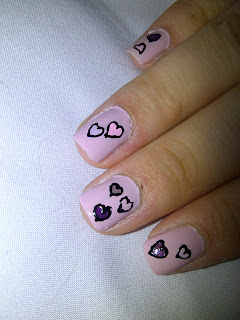Just before exam time, in an effort to do anything rather than revise, I have discovered marbling with nail paints. There are loads and loads of tutorials on youtube, but you often have to put up with annoying voices and they're often very slow.
So, here's my version:
1. Prepare a plastic cup with room-temperature water.
The cup should be quite small, about the length of an index finger and circumference of the ring you can make with middle finger and thumb. It should be disposable. The little plastic containers in which you get M&S puddings in are ideal, but any cup will do the trick.
2. Prep. your fingers.
This is a messy job so there are two ways to try to minimise the clean-up job.
The first is to cover the tip of your finger (from just under the top joint to the top of the finger) with sellotape. I used two strips: one to wrap round the joint and above (getting as close to the cuticle as possible) and the other to go from one side of the nail bed, to the other and covering the tip of the finger just under the nail.
The second way is to use Vaseline. This makes the clean-up job harder, but means you don't run the risk of sticking fingers together, ruining your design with tape etc. Cover the whole of the top of the finger (not the nail) with the jelly, it's that simple.
Both techniques should be done on only one hand at a time.
3. Choose your colours.
Anything goes.
4. Paint a base coat and an under-colour.
A base coat will protect your natural nails a little bit and give a smooth surface in which to work. Then, paint another coat of a coloured polish for the base colour. White is most commonly used, but pale pink or a colour used in your design is also great. Experimentation is key.
5. Marble!
After allowing your nails to completely dry, it's time to start creating. Arm yourself with cocktail sticks, cotton buds, nail polish remover (most convenient in a little pot) and kitchen paper and unscrew all the tops of the nail polishes you're using.
Drip a single drop of your first colour onto the surface of the water and allow it to spread (some are quicker than others but should take no more than about 5 seconds, if it needs help, gentle blowing on the polish or slightly moving the cup might help) Then drip your second colour inside the first. Continue with as many colours or repeat colours as you like until you get rings of polish that you like the look of. (Don't take too long or the polish will dry out)
Get a cocktail stick and create a pattern (you can pull the polish in from the very edges to make a flower, out from the centre to create a star, or just swirl it around randomly until you get a pattern you like.
5. Capture the design.
Choose the section you like and how to orientate it on the nail. Then, dip the your finger in so that the nail is parallel to the surface of the water and then leave your finger under the water and clean the film off the surface. The easiest way to so this is to spin and swirl a cotton bud around in the water and let it pick up all the remaining polish on the surface. Then, remove your finger.
Do steps 4 and 5 for all nails, if using sellotape, remove it when the polish is dry.
6. Clean-Up.
The worst part. Take some cotton buds and soak them in nail polish remover (this is where the little pot is helpful) Rub off any excess polish around the nail (a lot harder having used Vaseline rather than sellotape)
7. Top Coat.
Always top coat your design to protect it and add shine.
8. Rectify.
If there are any parts of the patten which need more detail, or the nails become chipped at any point, you can fill in gaps with a nail art pen.
DONE!
Shown below are the designs I created using the following polishes:
No.7 top coat and base coat
Barry M Silver Foil Effects 319 for under coat and in design
KIKO Nail Lacquer 338
17 Lasting Fix in Fairy Cake
No.7 Betty Blues 280
More designs to follow soon!



























.jpg)



















